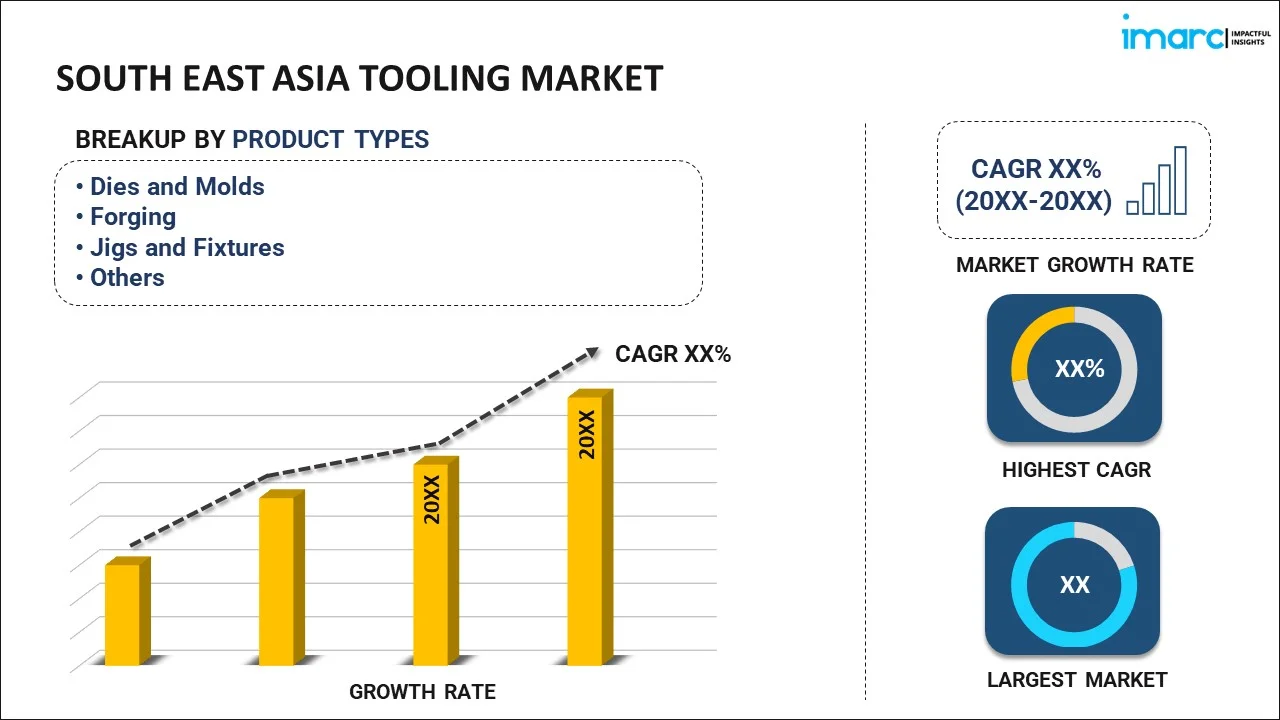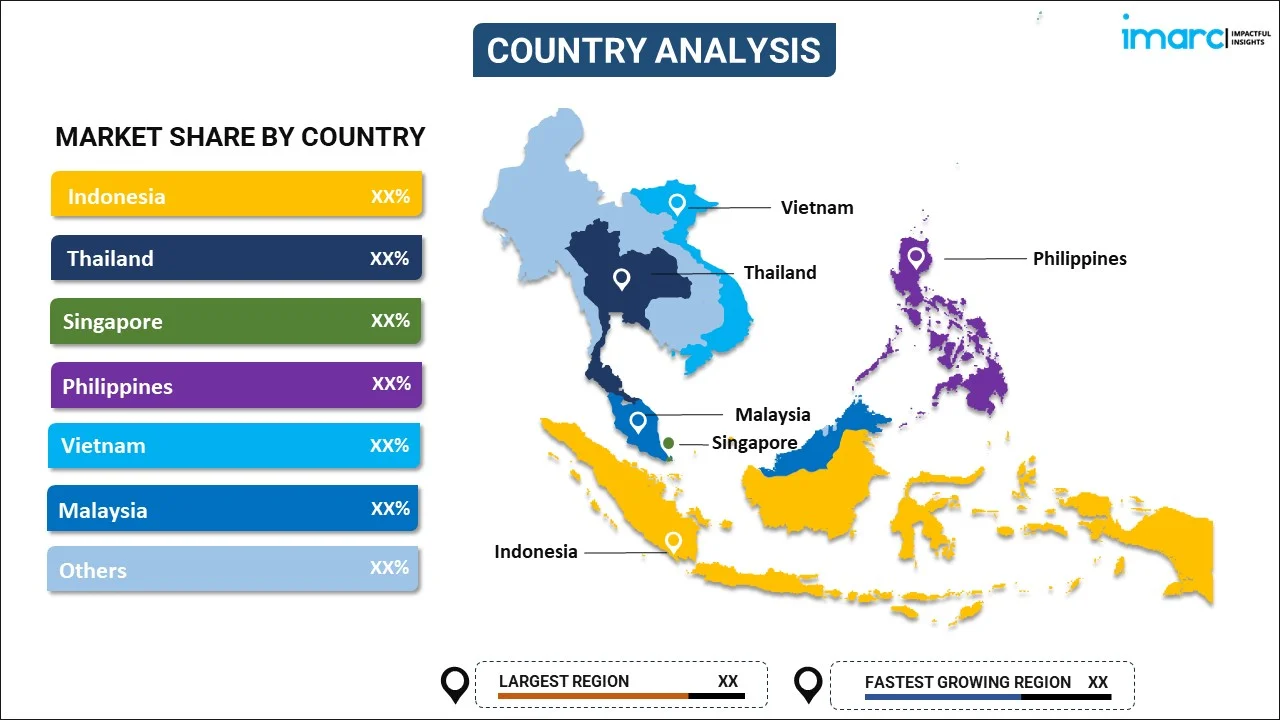
South East Asia Tooling Market Report by Product Type (Dies and Molds, Forging, Jigs and Fixtures, Machines Tools, Gauges), Material Type (Stainless Steel, Iron, Aluminium, and Others), End Use Industry (Automotive, Electronics and Electrical, Aerospace, Marine and Defense, Plastics Industry, Construction and Mining, and Others), and Country 2024-2032
Market Overview:
South East Asia tooling market size is projected to exhibit a growth rate (CAGR) of 2.80% during 2024-2032. The expanding aerospace and defense sectors, coupled with the rising demand for advanced tooling solutions that are capable of meeting stringent quality and safety standards, is driving the market.
|
Report Attribute
|
Key Statistics
|
|---|---|
|
Base Year
|
2023 |
|
Forecast Years
|
2024-2032
|
|
Historical Years
|
2018-2023
|
| Market Growth Rate (2024-2032) | 2.80% |
Tooling refers to a broad category of equipment and processes used in various industries to design, produce, and maintain products. It encompasses a diverse range of tools, machinery, and software that aid in manufacturing, construction, and other fields. Tooling plays a crucial role in the creation of prototypes, molds, and components, enabling the efficient and precise fabrication of complex parts. It involves the use of specialized equipment such as drills, lathes, and milling machines, as well as computer-aided design (CAD) software and computer-aided manufacturing (CAM) systems. Tooling is essential for achieving high levels of accuracy, consistency, and repeatability in production processes, contributing to the overall quality and cost-effectiveness of manufactured goods. With advancements in technology, tooling continues to evolve, incorporating automation, robotics, and additive manufacturing techniques to streamline operations and enhance productivity in modern industries. Efficient tooling practices are crucial for businesses aiming to remain competitive in today's dynamic and demanding market landscape.
South East Asia Tooling Market Trends:
The tooling market in South East Asia is propelled by several key drivers, chief among them being the increasing demand for advanced manufacturing capabilities. Consequently, this has led to a surge in the adoption of cutting-edge tools, thereby driving market growth. Moreover, the growing emphasis on precision engineering has necessitated the development of more sophisticated and precise tools, consequently fueling the expansion of the tooling market. In addition, the burgeoning focus on automation and efficiency enhancement across industries has led to a notable uptick in the demand for specialized automated tooling solutions. Consequently, this trend has significantly contributed to the market's upward trajectory as businesses seek to optimize their production processes and minimize operational costs. Furthermore, the rapid evolution of technology and the advent of Industry 4.0 have spurred a notable shift towards the integration of smart tools and connected systems, further bolstering the tooling market. Simultaneously, the increasing emphasis on sustainability and eco-friendly manufacturing practices, which has prompted a growing demand for environmentally conscious tooling solutions, is expected to drive the market in South East Asia during the forecast period.
South East Asia Tooling Market Segmentation:
IMARC Group provides an analysis of the key trends in each segment of the market, along with forecasts at the regional and country levels for 2024-2032. Our report has categorized the market based on product type, material type, and end use industry.
Product Type Insights:

- Dies and Molds
- Forging
- Jigs and Fixtures
- Machines Tools
- Gauges
The report has provided a detailed breakup and analysis of the market based on the product type. This includes dies and molds, forging, jigs and fixtures, machines tools, and gauges.
Material Type Insights:
- Stainless Steel
- Iron
- Aluminium
- Others
A detailed breakup and analysis of the market based on the material type have also been provided in the report. This includes stainless steel, iron, aluminium, and others.
End Use Industry Insights:
- Automotive
- Electronics and Electrical
- Aerospace, Marine and Defense
- Plastics Industry
- Construction and Mining
- Others
The report has provided a detailed breakup and analysis of the market based on the end use industry. This includes automotive, electronics and electrical, aerospace, marine and defense, plastics industry, construction and mining, and others.
Country Insights:

- Indonesia
- Thailand
- Singapore
- Philippines
- Vietnam
- Malaysia
- Others
The report has also provided a comprehensive analysis of all the major regional markets, which include Indonesia, Thailand, Singapore, Philippines, Vietnam, Malaysia, and Others.
Competitive Landscape:
The market research report has also provided a comprehensive analysis of the competitive landscape in the market. Competitive analysis such as market structure, key player positioning, top winning strategies, competitive dashboard, and company evaluation quadrant has been covered in the report. Also, detailed profiles of all major companies have been provided.
South East Asia Tooling Market Report Coverage:
| Report Features | Details |
|---|---|
| Base Year of the Analysis | 2023 |
| Historical Period | 2018-2023 |
| Forecast Period | 2024-2032 |
| Units | US$ Billion |
| Scope of the Report | Exploration of Historical and Forecast Trends, Industry Catalysts and Challenges, Segment-Wise Historical and Predictive Market Assessment:
|
| Product Types Covered | Dies and Molds, Forging, Jigs and Fixtures, Machines Tools, Gauges |
| Material Types Covered | Stainless Steel, Iron, Aluminium, Others |
| End Use Industries Covered | Automotive, Electronics and Electrical, Aerospace, Marine and Defense, Plastics Industry, Construction and Mining, Others |
| Countries Covered | Indonesia, Thailand, Singapore, Philippines, Vietnam, Malaysia, Others |
| Customization Scope | 10% Free Customization |
| Report Price and Purchase Option | Single User License: US$ 3699 Five User License: US$ 4699 Corporate License: US$ 5699 |
| Post-Sale Analyst Support | 10-12 Weeks |
| Delivery Format | PDF and Excel through Email (We can also provide the editable version of the report in PPT/Word format on special request) |
Key Questions Answered in This Report:
- How has the South East Asia tooling market performed so far and how will it perform in the coming years?
- What has been the impact of COVID-19 on the South East Asia tooling market?
- What is the breakup of the South East Asia tooling market on the basis of product type?
- What is the breakup of the South East Asia tooling market on the basis of material type?
- What is the breakup of the South East Asia tooling market on the basis of end use industry?
- What are the various stages in the value chain of the South East Asia tooling market?
- What are the key driving factors and challenges in the South East Asia tooling?
- What is the structure of the South East Asia tooling market and who are the key players?
- What is the degree of competition in the South East Asia tooling market?
Key Benefits for Stakeholders:
- IMARC’s industry report offers a comprehensive quantitative analysis of various market segments, historical and current market trends, market forecasts, and dynamics of the South East Asia tooling market from 2018-2032.
- The research report provides the latest information on the market drivers, challenges, and opportunities in the South East Asia tooling market.
- Porter's five forces analysis assist stakeholders in assessing the impact of new entrants, competitive rivalry, supplier power, buyer power, and the threat of substitution. It helps stakeholders to analyze the level of competition within the South East Asia tooling industry and its attractiveness.
- Competitive landscape allows stakeholders to understand their competitive environment and provides an insight into the current positions of key players in the market.
Need more help?
- Speak to our experienced analysts for insights on the current market scenarios.
- Include additional segments and countries to customize the report as per your requirement.
- Gain an unparalleled competitive advantage in your domain by understanding how to utilize the report and positively impacting your operations and revenue.
- For further assistance, please connect with our analysts.
 Inquire Before Buying
Inquire Before Buying
 Speak to an Analyst
Speak to an Analyst
 Request Brochure
Request Brochure
 Request Customization
Request Customization




.webp)




.webp)












